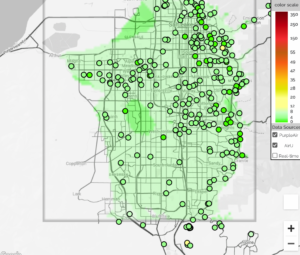 The Salt Lake County Health Department has launched AirView, an online, real-time air-quality monitoring map that is connected to a series of portable air quality sensors, including a network built and designed by University of Utah engineers.
The Salt Lake County Health Department has launched AirView, an online, real-time air-quality monitoring map that is connected to a series of portable air quality sensors, including a network built and designed by University of Utah engineers.
The new map, SaltLakeHealth.org is connected to the University of Utah’s AirU network — which was built by U chemical engineering associate professor Kerry Kelly, chemical engineering professor (lecturer) Tony Butterfield, School of Computing professor Ross Whitaker and electrical and computer engineering associate professor Pierre-Emmanuel Gaillardon — and the PurpleAir network. Both networks of sensors provide real-time measurements of the air’s concentration of particulate matter so users can get an instant look at how bad the air is in a particular area of Salt Lake County.
Below is the Salt Lake County Health Department press release announcing the new AirView map.
Salt Lake County Health Department (SLCoHD) announced today a new, online map at SaltLakeHealth.org that presents real-time air quality data from dozens of air monitoring sensors throughout the county. The map, called AirView, is available through a public-private partnership with TELLUS Networked Sensor Solutions.
AirView displays crowd-sourced readings from sensors connected to two different air quality sensor networks, AirU and PurpleAir, as well as measurements from state monitoring stations and displays each sensor as a color-coded dot based on the level of particulate matter (PM2.5) recorded at that location. TELLUS integrates the measurements from multiple sensors, corrects the measurements based on local conditions, and presents these results on an easy-to-understand map with the appropriate “health alert” color for particulate matter pollution.
“AirView is another tool for people who live, work and visit Salt Lake County to be aware of current air quality in their immediate area so they can make informed choices about their health and activities,” says Corbin Anderson, SLCoHD air quality bureau manager. “Checking AirView can help you decide to avoid motor vehicle travel, wear a particle-filtering mask while outdoors or change your furnace filter to improve indoor air quality.”
Because it relies on multiple sensor networks, AirView includes more sensors than other map visualizations currently available, such as the U.S. EPA’s AirNow, making AirView’s data more precise—and accurate—at the neighborhood level.
“Our team at the University of Utah spent years developing strategies to ensure that the measurements and visualizations are accurate, for example by screening the measurements for outliers, by developing local and seasonal correction factors for the AirU and PurpleAir sensor networks, and by comparing our results to reference measurements from the Utah Division of Air Quality,” said Dr. Kerry Kelly, University of Utah associate professor and cofounder of TELLUS. “These strategies help people make sense of the often-imperfect data coming from crowd-sourced measurements. We are delighted that these technologies are now available to our community and can help individuals and policy makers make informed decisions about air quality and their personal exposure.”
“Information is power, and this will help residents make good decisions to protect their health and businesses know when to encourage employees to work from home,” said Salt Lake County Mayor Jenny Wilson. “Air quality is something all families in Salt Lake County worry about and this is a great tool to have as we head into the winter and inversion months.”
Health officials also remind Salt Lake County residents that, from November 1–March 1 each year, burning solid fuels (wood, coal or pellets) is prohibited in Salt Lake County unless the Utah Division of Air Quality determines it is an “unrestricted action” day. In Salt Lake County, days labeled by the state as “voluntary action” or “mandatory action” are both NO BURN days.
The burning prohibition includes fireplaces, heating stoves (including “EPA-certified” stoves) and outdoor fires (bonfires, patio fire pits), though burning for heat in an emergency, such as a power outage, is allowed.
Particulate pollution is particularly dangerous to health—even more than unattractive smog that is visible to the naked eye. The tiny, microscopic particles created by burning wood and other solid fuels can enter the blood stream and cause breathing and heart problems.
Due to natural, regional conditions out of our control that can negatively affect air quality (weather patterns and topography), Anderson says, “It’s essential that Salt Lake County residents be vigilant about the things that are in our control, particularly managing combustion emissions during times of deteriorating air quality, such as the winter inversion season or regional wildfire events. Due to climate change, we expect wildfires will occur with greater frequency and will span a longer portion of the year, so year-round awareness is important.”
Learn more about TELLUS Networked Sensor Solutions at tellusensors.com.